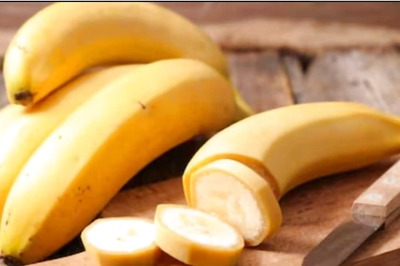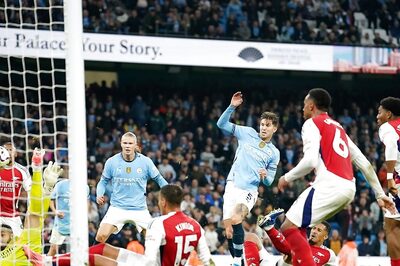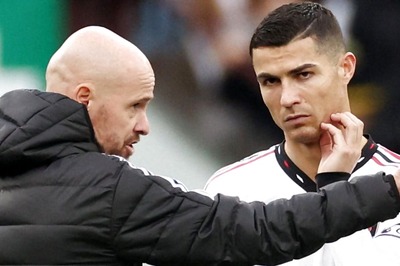
views
For Anant Ambani, the youngest son of Reliance Industries chairman Mukesh Ambani and Reliance Foundation founder and chairperson Nita Ambani, 2024 promises to be a special year.
The Ambani scion, who is set to marry Radhika Merchant later this year, is gearing up for his pre-wedding festivities in Gujarat’s Jamnagar from March 1-3 that will see the who’s who of the worlds of entertainment, business, technology and sports grace the occasion.
Amidst his hectic schedule, Anant took out time for a chat with CNN-News18’s Anand Narasimhan about a project extremely close to his heart — the launch of Vantara (Star of the Forest) programme, an umbrella initiative to focus on rescue, treatment, care and rehabilitation of injured, abused and threatened animals.
Housed within the Green Belt of Reliance’s Jamnagar Refinery Complex in Gujarat, Vantara aims to be one of the leading contributors to conservation efforts globally. By working with leading experts in animal care and welfare, Vantara has converted a sprawling space into a jungle-like environment that mimics the natural, enriching, lush and verdant habitat for the rescued species to thrive in.
The Vantara initiative, the first-of-its-kind in India, has been conceptualised and birthed under the passionate leadership of Anant Ambani. Anant is also spearheading Reliance’s ambitious renewable energy business in Jamnagar, and, in that capacity, is responsible for leading Reliance’s journey to become a Net Carbon Zero company by 2035.
Edited excerpts:
I am standing in the middle of a state-of-the-art operation theatre, ladies and gentlemen, with the works. In terms of medical equipment, this is even powered by robotics. But the important point is that it’s not for human beings. It’s for lives that we often times don’t value. But perhaps they are most important in our food chain. It’s for wild animals. And it’s perhaps a one-of-a-kind rescue and rehabilitation centre that I find myself in. And I’m so proud to be able to speak with a person who’s at the heart of it all and who has championed it right from the ground up — Mr Anant Ambani. Anant-ji, Namaste.
How are you? Namaste.
Let me first ask you, where are we, and can you take our viewers through this? And then we’ll get into the genesis of where we are in Vantara.
Currently, you are in our large animal operation theatre. This is our hospital. It’s spread over one-and-a-half lakh square feet. You can see we have a gas anaesthesia machine. We have state-of-the-art operation table, operation lights. We have an entire robotic endoscopic machine which we can also do robotic surgery with. We have ventilators. We have everything which is state of the art. I personally have not seen such a well-equipped ICU. So, before I could build this, I visited more than 30 or 40 facilities all across the world, and I took inspiration from every one of them. And those were my inspiration to build this.
True. Now, this is a smaller animal facility. These are primates and felines, and those are the ones which are here. There’s a huge elephant hospital that they’ve also built. That is the Radhe Krishna Elephant Wellbeing Trust. And that was phenomenal to see more than 100 elephants that we saw there.
We have rescued actually more than 200 elephants from all across India.
Now, that’s not easy. Tell me, how did that happen? What’s the genesis of this?
So my mother has always been a great inspiration to me. My mother, when I was a young boy and we were going, I was, I think, 12 years old, we were traveling from Jaipur to Ranthambore. In the middle, on the road, we saw a young elephant with a ‘mahavat’ in the peak heat, and the elephant was walking a little weirdly. So I told my mom, we want to rescue it. So that was the first elephant. And we had no idea how to take care of elephants. So we got the elephant, we kept it. And then we said, we’ll build slowly, slowly. Boond, boond se sagar banta hai. At that time we did not even know what to feed the elephant. We would do what the ‘mahavat’ says. We had no scientific knowledge. We built a scientific knowledge over a period of, I think, a decade and more. Today we have a highly professional team, more than 300-400 professionals, taking care of the elephants.
How big is this entire facility, if I may ask you?
So all our animal facilities put together are spread over more than 2,500 acres.
That’s a lot of space. And this is in Jamnagar. So Jamnagar is also where your refinery is…
I would say this is my father’s and my grandfather’s dream. They’ve worked very hard. We have the world’s largest refinery. We’re getting the world’s largest new energy plant here. And they’ve built everything from scratch. My mother built the township where all our employees live. She’s created a city and it was a barren desert. And thanks to my parents, this exists. Even I have seen Jamnagar since 1997. The villages around have prospered so much. It’s something amazing.
True. Now, in the heart of all of this enterprise, where Reliance core and perhaps its ancillary and affiliates overall influenced more than a one-and-a-half crore lives — correct me if my numbers are wrong. Amidst all of that, you thought of saying, okay, let’s go and help those who can’t talk for themselves.
So Anand, basically, when I was a young child, my mother always would tell me to take care of the animals.
So in your childhood also you would do this?
I would do it in my childhood. And my father is one of the biggest wildlife buffs. For example, when we were young, I think till the age of 18, I’ve not gone to any other family holiday except Africa, Ranthambore and the jungles of Kanha, Bandhavgarh and Kaziranga. My father would only take us to jungle holidays. So I think they inspired me to do this. And to be honest, for domestic animals, there are many people who are doing a lot of good work across the country.
Correct.
For wildlife, there are very few people and wildlife is getting endangered here. We have more than 50-60 endangered species.
50-60 endangered species?
Yes, that we’ve rescued. From various backgrounds, like circuses, from road accidents, from animal-human conflict, from zoos which are overcrowded. We have rescued animals from all across, from hunting lodges in South Africa and from other places. So while we were rescuing them, I thought that we need a state-of-the-art hospital. We need a state-of-the-art facility. I don’t want to keep them in cages. I want to keep them in the natural habitat. So we worked very hard. You saw today, I showed you. We have mimicked the natural habitat to the T, to the best of my ability. And my team is more important than me. There’s a trust, and the trust runs it. So the team has created a wildlife sanctuary, and each enclosure has its own biodiversity, from the plants to the water body to even the rocks. And the logs are from originally where the animals came from. Our focus is that India should not have any wild animals suffering in captivity, or any wild animals should not go without being treated.
That’s a very, very big thought because we are very rich in fauna; flora and fauna. So does that also open you up to scrutiny? Are people asking, what is this person doing in Jamnagar? Is he really creating a rescue and a rehabilitation centre?
Of course. When you do something, there’ll be a lot of people who will praise you and a lot of people who do not praise you. At the end of the day, in my heart, I know I’m true and I’m doing it for animals. And as long as I know what I’m doing, I don’t worry about what others have to say.
I believe there were some people who came and checked also.
We have had many. The trusts have been going to court many times, and we have always argued well, and we are legally compliant. We comply with every statutory compliance… Getting an animal is not easy. Ministry of Environment, Forest and Climate Change of India has certain guidelines. The state government has guidelines. We are extremely regulated. We follow every law to the T.
So you will stand the test of legal scrutiny in terms of this endeavour because it’s important, because what you’re doing is very significant. So let me ask you, you’re also very ‘dharmic’. So is there a Sanatan connect to it all?
Of course. So, as you know that in our Sanatan, every deity has an animal which is close to her or his heart. Every deity has a vahana. Vahana is that animal. And in our Rig Veda, Krishna says that all life is equal, made be a human or made be a bee, or may it be an ant. Everything is equal. Here we take care [of animals] from frogs to mice to everything.
But what does it do for you? Why do you do it? Everybody has money. Some people have little, some people have lots of money. Everybody does different things with them. You need to have a cause.
Something that drives my cause is animal welfare. There are a lot of people working [for human welfare] but in animal welfare, there are few people working. I think I was the chosen one and I was fortunate enough that God’s blessings… that I could do Seva of animals. For me, in today’s life, you can’t see God but I see God within every animal. They say in our dharm that in a cow, there are 64 crore ‘devtas’. But for me, not only in a cow, but I see in every animal. So it’s my giving back to society.
Does it help you heal?
Yes, of course. So I’ve healed a lot in my own way and I think it’s all because of the animals. I’ve had my own battles with myself, battles with health. But I’ve overcome that. And I think one of the biggest reasons is the blessings of these animals who we have rescued. And more than that, it also makes me feel that we’re contributing back to society in some way.
So what’s your vision with this? Where are we going with this? Are you creating something that is going to be perennial?
Luckily I’m getting married now.
Yes, you are. Congratulations.
I’m going to have one more person. Radhika is also extremely passionate about this. So I think both of us combined and with my parents’ blessings and my siblings Akash and Isha’s blessings, I think what you’ve seen now is only 8- 10 per cent of my vision.
My vision is that at Vantara in Jamnagar, we would like to be the world’s most advanced wildlife institute and we would also like to conserve and breed critically endangered species so we can release them back in the habitat. Because a lot of species, even today, as we speak, are going extinct.
So, in Hindi there’s a saying called Chidiyaghar. It’s not a Chidiya Sevalaya. So we have created it as a Sevalaya. And it’s an area where we only rehabilitate, rescue, preserve, conserve and breed the endangered species. It’s not a zoo. It’s not for any entertainment.
Yeah, I was coming to that. So you’re saying it’s a ‘pashu sevalaya, not a pashu sangrahalaya’. So that’s what it is. So is there a plan to also… Are you changing lives because feeding, say, 100 plus elephants?
More than 200 elephants.
200 elephants. That’s a lot of food.
We have rescued till date more than 20,000 wild animals.
Where do you procure all of that? So are you helping people?
So we farm a lot of our stuff locally. So we have helped the local farmers. So we tell them organic manure from our gaushalas, from our elephant, should be given to the farmers. So they also have an economy. We farm the feed. An elephant needs 200 kilos of fodder a day. So we have 200 elephants. So imagine the amount of food. So everything is made in India, grown in India, grown locally as much as possible. And also there’s an economy of more than 10,000 people based on this whole rescue centre.
Fantastic. And are you training youngsters? Are you training talent which can perhaps go and help our zoos.
We have got more than 30 expats who are here in either teaching capacity or they are professors or they are scientists. We take young students. We have more than 100 and 5200 veterinary doctors who are young, just fresh graduates. We train them fully. Our aim is there are 150 zoos in the country. Our aim is that India should have the best zoos across the world. India should have the best rescue centres across the world. India should have one of the best state-of-the-art animal rescue, like people, people who rescue animals, wildlife preservation in India. That’s our aim. And this is going to be the premier station. But I would like to say that this is just 8-10 per cent. I think boond, boond se sagar banta hai.
I need to put in final two questions. You’re going to be championing the country’s green energy also. That’s a big, big thing on your shoulders. So how much time are you able to take out?
So I have a philosophy. This is my passion project. So I give about one hour a day or one-and-a-half hour a day to Vantara where we do animal rescue. The rest of the time I’m devoted to my father and I give about 14 hours a day.
No matter what, however difficult it is, one, one-and-a-half hours and weekends. For me, Jamnagar is my home. So I try to base myself over here on weekends and whenever I get a holiday. So Radhika would complain a lot [earlier]. But Radhika now loves it… Now she wants to come to take care of the animals more than me. So Radhika is a great support.
So she’s also gotten involved into it?
She’s got involved.
So let me ask you, do you have a personal favourite? You’ve rescued so many animals.
My mother, mostly rescued Gauri, our first elephant. And my mother, as you know, is my biggest inspiration. And I think Gauri is our favourite amongst the family. And my brother’s son Prithvi, his only vacation is Jamnagar. So whenever he gets up, my whole family’s vacation point is Jamnagar. We don’t go anywhere else.
So are you going to allow others also to come and study, learn? Are you going to open it?
This is going to be an education hub. As you know, we have more than 200 rescued elephants. We have more than 150 rescued leopards. This is going to be an education hub. We’re just waiting for the right time to open to the public. We don’t want the cage concept. We don’t want people to come and see. Animals should not be used as a source of entertainment.
[At Vantara] Not a single elephant was caged or chained.
Every exhibit was made at a natural way. So we are hoping to open to the public soon. And this is a complete not-for-profit endeavour. We have no business interests in this endeavour.
Fantastic. Phenomenal. And I’m waiting for the day when my kids can also come. Congratulations once again. Thank you so much.
Thank you.




















Comments
0 comment